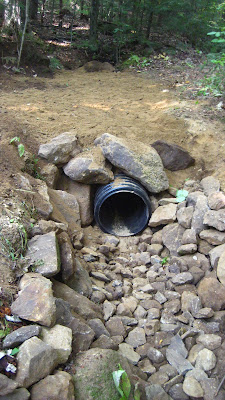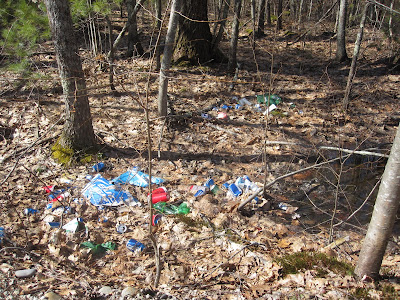Now that the snow is almost gone, it's a great time to get out on your Reservation and do a little spring cleaning. What are the best tools to take with you on a spring cleaning foray? I like a shovel or hoe of some sort, a hand saw, and a plastic trash bag at this time of year... and here's what I use them for:
1. Clean out Culverts - if there are any culverts on the roads and/or trails on your reservation, spring is a good time to make sure they're running free. Culverts can easily plug with sediment and debris over the course of fall and winter, and if they block the flow of water completely, the consequences can be disastrous. Use your shovel or hoe to scrape debris out of the culvert's intake and outflow as best as you can.


culvert failure
2. Clean Waterbars & Drainages - The upslope side of trail waterbars should have a nice drainage channel to divert water off trail. If those on your property have filled in with dirt, leaves, or other debris and are flush with the bar itself, they're due for a cleaning. Scrape out any accumulated debris with your shovel or hoe and restore the drain channel. Be sure it extends well off the side of the trail so the water won't just pour back on the trail a little further down!

a waterbar (looking downslope) with cleaned drain channel (Photo: P. Ellis)
3. Take out the Trash - After all that dirty snow melts, you will inevitably find trash items (cans, bottles, food packaging) along your property's road frontage, and possibly along trails as well. Remembering to bring a plastic trash bag with you is a good idea at any time of year, since you can whip it out to hold all those yucky rubbish items when you run into them.

4. Watch for Windfall - Winter storms often leave branches, large limbs, and sometimes even whole trees across the trail system. Early spring is a great time to get out and make sure the trail is passable for recreational users. Here's where your handsaw will come in handy... use it to help you saw larger branches and remove them from the trail corridor. If large trees have fallen, you may use a chainsaw as long as you have completed SPNHF's Chainsaw Safety and Maintenance Workshop and feel you have the skills to remove the tree safely. If not, alert Forest Society staff to the problem and we'll do our best to get out and clear the trail as soon as we can!
Winter Blowdown - only tackle these if you feel confident you can do it safely (photo: L. Martin)